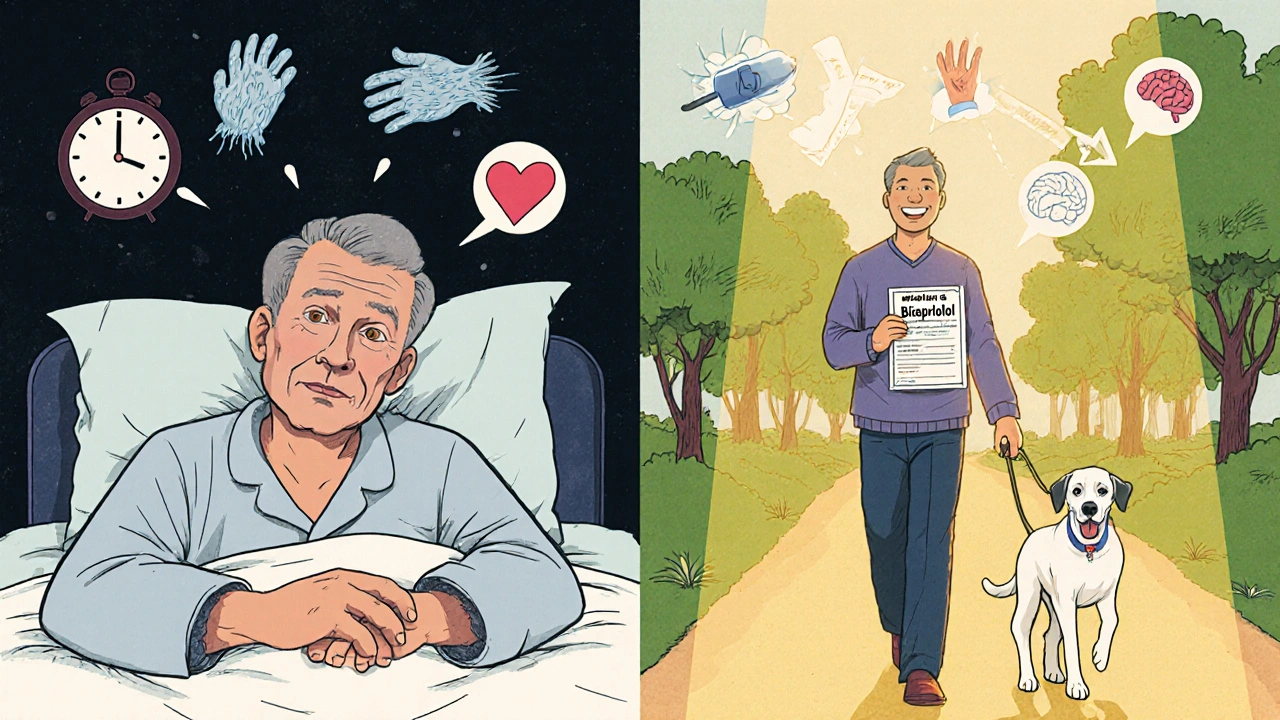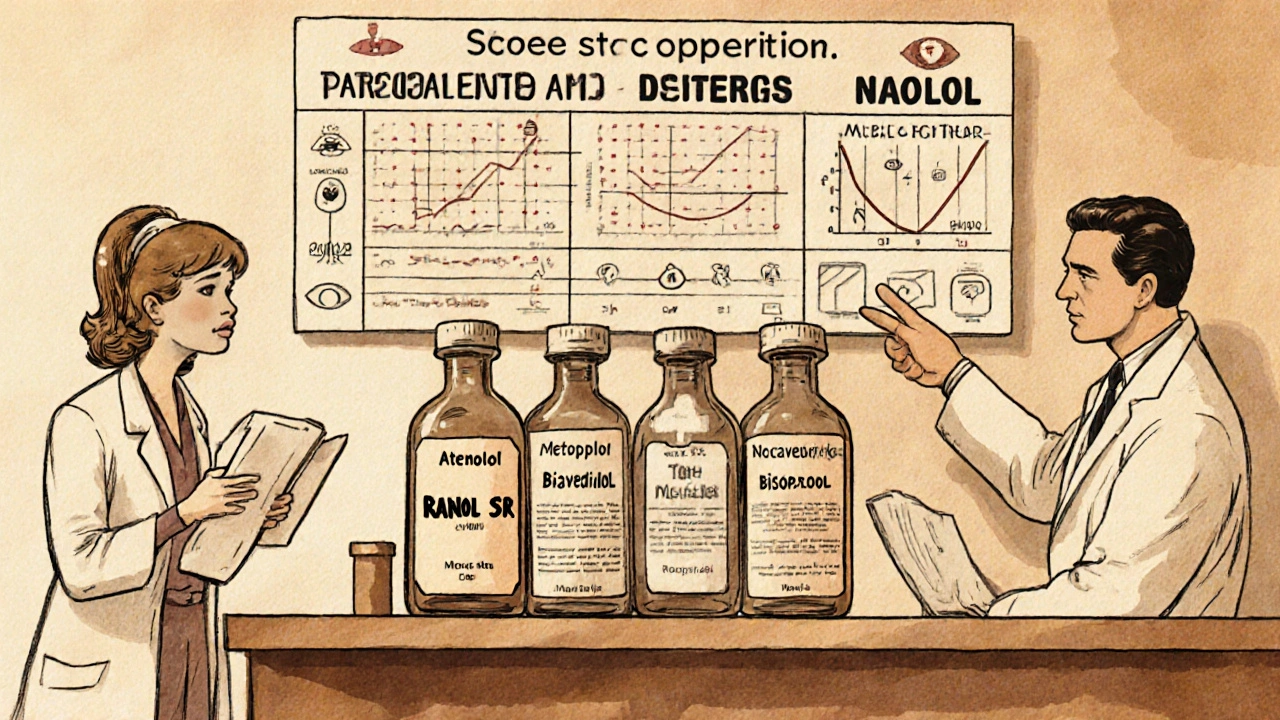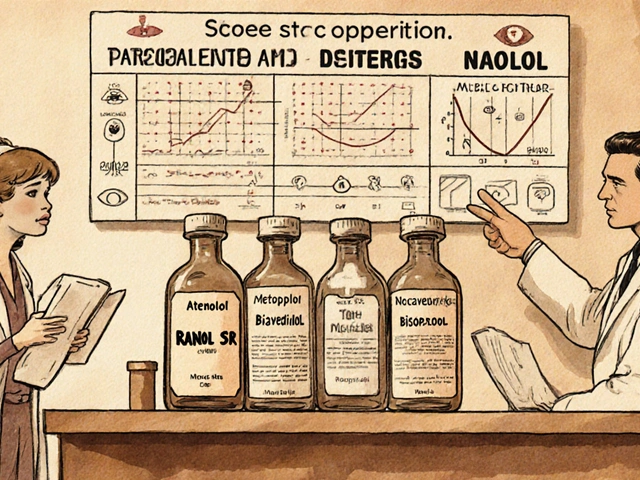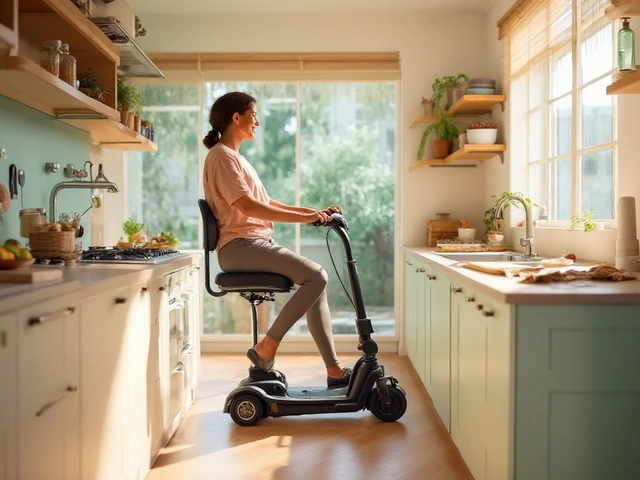Propranolol is one of the most prescribed beta blockers in the world. Sold under brand names like Ranol SR, it’s used for high blood pressure, angina, irregular heartbeats, and even anxiety or migraine prevention. But it’s not the only option. Many people switch because of side effects, cost, or lack of results. So how do you know if Ranol SR is right for you-or if another beta blocker might work better?
What Ranol SR (Propranolol) Actually Does
Ranol SR is a sustained-release version of propranolol. That means it releases the drug slowly over 12-24 hours, so you take it once or twice daily instead of every 6-8 hours. It blocks adrenaline from binding to beta receptors in your heart and blood vessels. This slows your heart rate, lowers blood pressure, and reduces the heart’s demand for oxygen.
It’s not just for heart conditions. Doctors also prescribe it off-label for performance anxiety, tremors, and preventing migraine headaches. In fact, a 2023 study in The Journal of Clinical Hypertension showed that propranolol reduced migraine frequency by 50% in 62% of patients over 12 weeks.
But it doesn’t work for everyone. Common side effects include fatigue, dizziness, cold hands or feet, and in some cases, depression or sleep disturbances. If you’re struggling with these, it’s worth looking at alternatives.
Top Alternatives to Ranol SR (Propranolol)
There are several other beta blockers that do similar things-but with different profiles. Here are the most commonly prescribed ones:
- Atenolol - Less likely to cross the blood-brain barrier, so fewer brain-related side effects like nightmares or depression. Often used for high blood pressure and heart rhythm control.
- Metoprolol succinate (Toprol XL) - Also extended-release. More heart-specific than propranolol, meaning it’s less likely to cause cold extremities or affect breathing in people with mild asthma.
- Carvedilol - Blocks both beta and alpha receptors. Often used after heart attacks or for heart failure. May cause more dizziness but can be better for people with metabolic syndrome.
- Bisoprolol - Highly selective for the heart. Lower risk of fatigue and impotence compared to propranolol. Popular in Europe and gaining traction in the U.S.
- Nadolol - Long-acting like Ranol SR, taken once daily. Often cheaper than brand-name options and used for hypertension and arrhythmias.
Each has trade-offs. For example, if you have asthma, propranolol and atenolol can make breathing harder. Metoprolol and bisoprolol are safer here because they target the heart more specifically.
Comparison Table: Ranol SR vs. Key Alternatives
| Medication | Release Type | Dosing Frequency | Heart Selectivity | Common Side Effects | Best For |
|---|---|---|---|---|---|
| Ranol SR (Propranolol) | Sustained-release | 1-2 times daily | Non-selective | Fatigue, cold limbs, depression, sleep issues | High blood pressure, migraines, anxiety, tremors |
| Atenolol | Immediate-release | Once daily | Cardioselective | Dizziness, low heart rate, cold feet | Simple hypertension, cost-sensitive patients |
| Metoprolol succinate (Toprol XL) | Sustained-release | Once daily | Cardioselective | Fatigue, dizziness, mild asthma risk | Post-heart attack, angina, heart failure |
| Carvedilol | Immediate-release | Twice daily | Non-selective + alpha-blocker | Dizziness, swelling, low blood pressure | Heart failure, metabolic syndrome |
| Bisoprolol | Sustained-release | Once daily | Highly cardioselective | Headache, mild fatigue | Older adults, those with anxiety or sexual side effect concerns |
| Nadolol | Immediate-release | Once daily | Non-selective | Fatigue, dizziness, slow heart rate | Long-term hypertension, budget-friendly option |
As you can see, Ranol SR is broad-acting. That’s useful for conditions like migraines or tremors where you need the drug to affect more than just the heart. But if your main issue is high blood pressure or heart disease, a more targeted option might give you the same benefit with fewer side effects.

When to Stick With Ranol SR
Don’t assume a newer or pricier drug is better. Propranolol has been around since the 1960s. It’s well-studied, effective, and often the cheapest option-especially as a generic.
You should consider staying on Ranol SR if:
- You’re using it for migraines or performance anxiety-other beta blockers don’t have as strong evidence here.
- You’ve tried alternatives and had worse side effects.
- You’re on a tight budget and generics are your only option.
- Your doctor has fine-tuned your dose and you’re stable.
One 2024 analysis of over 12,000 patients found that those who stayed on propranolol for migraines had a 41% lower rate of emergency visits compared to those who switched to other preventatives.
When to Switch
Switching makes sense if:
- You’re experiencing depression, vivid nightmares, or severe fatigue that affects your daily life.
- You have asthma or COPD-propranolol can trigger bronchospasm.
- Your blood pressure isn’t controlled, even at the maximum dose.
- You’re taking multiple medications and your doctor suspects drug interactions.
- You’re young and concerned about sexual side effects-bisoprolol and metoprolol are less likely to cause this.
Switching isn’t just about swapping pills. Your doctor will likely taper you off propranolol slowly. Stopping suddenly can cause rebound high blood pressure, chest pain, or even heart attack.
Non-Beta Blocker Alternatives
Not everyone needs a beta blocker. Depending on your condition, other classes of drugs might work better:
- ACE inhibitors (like lisinopril) or ARBs (like losartan) - Often first-line for high blood pressure, especially if you have diabetes or kidney disease.
- Calcium channel blockers (like amlodipine) - Great for older adults, people with angina, or those who can’t tolerate beta blockers.
- Diuretics (like hydrochlorothiazide) - Cheap and effective for mild hypertension, especially in African American patients.
- Anti-seizure drugs (like topiramate) - Sometimes used for migraine prevention instead of beta blockers.
- Cognitive behavioral therapy - Proven to reduce performance anxiety as effectively as propranolol, without side effects.
For example, a 2025 meta-analysis in The Lancet found that amlodipine lowered systolic blood pressure just as well as propranolol in patients over 65-but with fewer reports of fatigue or dizziness.
What Your Doctor Will Consider Before Switching
Doctors don’t switch medications on a whim. They look at:
- Your age, kidney and liver function
- Other conditions you have (diabetes, asthma, depression)
- Current medications (some interact badly with beta blockers)
- Cost and insurance coverage
- Your personal goals-are you trying to improve energy, sleep, or exercise tolerance?
If you’re asking for a switch, come prepared. Write down your symptoms, side effects, and what you hope to change. Say something like: "I’ve been on Ranol SR for six months, but I’m too tired to walk my dog. Is there another option that won’t make me feel this drained?"
Real-Life Scenarios
Case 1: Maria, 58 - Diagnosed with hypertension. On Ranol SR, but feels sluggish and can’t sleep. Switched to bisoprolol. Within two weeks, energy improved, sleep returned. Blood pressure stayed controlled.
Case 2: James, 32 - Uses Ranol SR for stage fright before public speaking. Tried metoprolol, but it didn’t help his trembling hands. Stayed on propranolol because it’s the only one that works for his tremors.
Case 3: Linda, 71 - Had a heart attack. Her cardiologist switched her from propranolol to carvedilol because studies show it improves survival after heart attacks. She now takes it with a statin and aspirin.
There’s no one-size-fits-all. What works for one person might not work for another-even if they have the same diagnosis.
Final Thoughts: It’s About Fit, Not Just Function
Ranol SR (propranolol) is a powerful, well-tested tool. But it’s not the only one. The best medication isn’t the one with the most studies-it’s the one that works for you without making your life worse.
If you’re unhappy with your current treatment, talk to your doctor. Bring this info. Ask about alternatives. Don’t assume you’re stuck. Many people feel better after switching-sometimes dramatically.
And if cost is a concern, ask about generic propranolol. It’s often under $10 a month. Sometimes, the cheapest option is still the best.
Is Ranol SR the same as propranolol?
Yes. Ranol SR is a brand-name version of propranolol with a sustained-release formula. The active ingredient is identical. Generic propranolol ER (extended-release) works the same way and is usually much cheaper.
Can I switch from Ranol SR to metoprolol on my own?
No. Stopping propranolol suddenly can cause dangerous spikes in blood pressure or heart rate. Always taper under medical supervision. Your doctor will gradually reduce your dose while introducing the new medication.
Which beta blocker is best for anxiety?
Propranolol is the most studied for performance anxiety because it blocks physical symptoms like rapid heartbeat and shaking. Other beta blockers like atenolol or bisoprolol may help, but they’re less reliable for tremors. For long-term anxiety, therapy or SSRIs are often preferred.
Does propranolol cause weight gain?
Some people gain a few pounds on propranolol, likely due to reduced metabolism and fatigue leading to less activity. Metoprolol and bisoprolol are less associated with weight gain. If this is a concern, ask your doctor about alternatives.
Are there natural alternatives to beta blockers?
No natural supplement replaces beta blockers for serious conditions like heart disease or hypertension. However, lifestyle changes-like reducing salt, exercising, losing weight, and practicing mindfulness-can lower blood pressure significantly. For mild anxiety, magnesium, L-theanine, or breathing exercises may help reduce physical symptoms.
How long does it take for a new beta blocker to work?
Blood pressure effects usually show within 1-2 weeks. For migraines or anxiety, it can take 3-6 weeks to see full results. Don’t judge effectiveness too soon. Give it time, and track your symptoms daily.







Write a comment
Your email address will be restricted to us